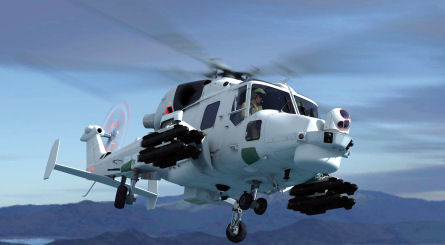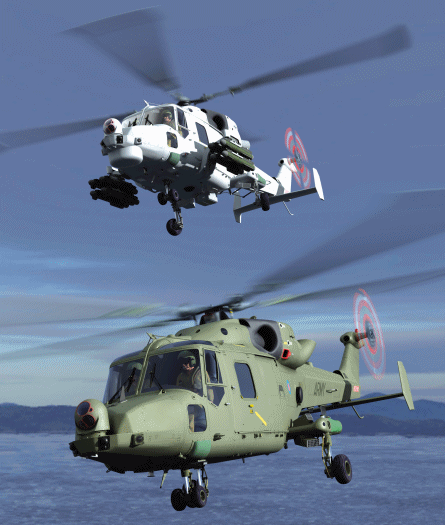The UK armed forces' Future Lynx light helicopter programme is on schedule to achieve two key milestones this month, with first metal to be cut on its initial flight-test aircraft, and project partners AgustaWestland and the UK Ministry of Defence to conduct an interim critical design review on the air vehicle system.
To enter frontline service with the British Army in 2014 as the Battlefield Reconnaissance Helicopter (BRH) and with the UK Royal Navy in 2015 as the Surface Combatant Maritime Rotorcraft (SCMR), the Future Lynx is being developed under a 70-aircraft deal that will deliver the variants with over 90% commonality. The aircraft - 10 more of which are also listed as options - will be produced at AgustaWestland's Yeovil plant in Somerset under the framework of a strategic partnering agreement signed between the company and the MoD alongside the £1 billion ($2.04 billion) development and manufacturing phase contract in June 2006.
|
|---|
The Royal Navy's Future Lynx fleet will specialise in anti-surface warfare missions |
Each aircraft will use some components drawn from the UK's fleet of around 150 Lynx, such as fuel system and main rotor gearbox parts. However, this list has been reduced since contract signature to around 50 "donor items", leaving more than 95% of the aircraft as new content, says David Hillcoat, AgustaWestland's head of the Future Lynx programme. "The aircraft looks the same, but it's completely new."
Oldland CNC will begin machining the first monolithic airframe component for the Future Lynx at its Bristol site on 24 October under subcontract to GKN Aerostructures, with the part to be used by one of three test airframes, the first two of which will be in army configuration. The first test aircraft will be delivered by the end of next year, with its flight debut scheduled for November 2009 and production deliveries to run from 2011.
A substantial part of the project design activity and 115 preliminary design reviews have been completed, and a full air vehicle critical design review will take place in April, says Hillcoat. "A lot of the time to date has been spent on confirming the LRU [line replaceable unit] positions and the overall hardware architecture of the aircraft. We're in a relatively stable position now."
Making extensive use of advanced manufacturing techniques and - for the first time for a new aircraft at Yeovil - also using a full digital mock-up, the Future Lynx will have a maximum take-off weight of 5,790kg (12,800lb) at introduction to service an increase of more than 1t over current UK Lynx variants. This will later grow to 6,250kg, due to a 10% increase in power output from the aircraft's two LHTEC (Rolls-Royce/Honeywell) CTS800-4N engines and the addition of BERP IV main rotor blades. Currently rated at a maximum of 1,360shp (1,000kW), the powerplant will deliver a significant increase in capability against the legacy R-R Gem, rated at up to 900shp.
Common components
The Future Lynx's new faceted tail section, low-set tailplane with end plates and new tail rotor will also improve handling qualities, according to AgustaWestland. The new tail rotor system will first be flown on a Super Lynx 300 demonstrator, while the company recently launched the manufacture of new transmissions and work to de-risk modifications to the aircraft's main gearbox.
Offering an extended airframe life of 12,000 flight hours, up from a previous 10,000 maximum, the army and naval aircraft will also share common components such as a strengthened landing gear, Thales avionics suite, General Electric (formerly Smiths) health and usage monitoring system and General Dynamics tactical processors. These systems are among contracts now in place worth 76% of the total programme subcontract value, along with cockpit displays, aerostructures, a Selex Sensors and Airborne Systems defensive aids suite and L-3 Wescam electro-optical/target designation sensors.
The Future Lynx cockpit has four 10 x 8in (255 x 200mm) multifunction displays with digital video inputs, with human-machine interface work being conducted to determine the level of integration required across the system. This work is being supported by current Lynx pilots using a simulator at Yeovil, says Hillcoat, who adds: "We're trying to make sure that we get an appropriate level of pilot workload."
The aircraft's wider avionics fit will include secure communications, successor identification friend-or-foe equipment, an integrated data modem and two 1553B databuses, and work will start during 2008 to test the equipment using a system integration rig.
Key configuration differences between the BRH and SCMR models will include connectivity with the Bowman battlefield communication system for the army and use of the Selex Seaspray 7000E active electronically scanned array maritime radar for the navy.
Weapon options
The army's late shift from a battlefield light utility helicopter requirement to the reconnaissance role will see its 40 aircraft configured to operate with a crew of two, plus a door gunner for 7.62mm or 12.7mm machine guns and a two-strong reconnaissance unit. Required to provide a 5h endurance over an operating radius of 200km (110nm), the aircraft could also be used for utility/troop transport, command-and-control and Special Forces fire control duties. The BRH will feature increased range and payload over the current Lynx AH7/9, but under current plans will not be required to carry air-to-surface missiles.
The primary role for the RN's 30 SCMR aircraft will meanwhile be to perform anti-surface warfare tasks, with each aircraft required to carry up to eight Future Air-to-Surface Guided Weapons (FASGW) 185km from a host ship and remain on station for 1h. The aircraft will also carry the BAE Systems Stingray torpedo for anti-submarine warfare missions, and utility tasks are also expected.
An initial gate decision is expected on FASGW in early 2008, with assessments focusing on whether to replace the Lynx HMA8's MBDA Sea Skua anti-ship missile with a light or heavy weapon. Candidates are likely to include precision-guided rockets and air-to-surface missiles such as Lockheed Martin's AGM-114 Hellfire and MBDA's Sea Skua 2.
All Future Lynx aircraft will share the same defensive aids configuration, with selected equipment including missile warning sensors, radar warning receivers and countermeasures dispensers, in many cases providing commonality with the British Army's Boeing/Westland Apache AH-1 attack helicopters. The CTS800 engine will also use an infrared exhaust suppressor for enhanced protection against surface-to-air missiles.
To run until 2017, AgustaWestland's development and manufacturing contract is split into three phases, respectively covering activity up to first flight, flight trials and production. "For each one of those we have to achieve various milestones in order to progress," says Hillcoat. "To date, we have achieved all of the milestones on schedule."
AgustaWestland has meanwhile also been confirmed as the MoD's "training service enabler" for the Future Lynx programme, with the parties to work in conjunction during a forthcoming competition, for which invitations to negotiate are likely to be issued next April. "The MoD recognises the role of the design authority for effective configuration management and integration with the platform programme," says Hillcoat.
Joint test team
The company is also discussing the details of a Future Lynx release-to-service contract with the MoD, with a joint combined test team to be supported by UK research and technology company Qinetiq. Along with through-life logistics support, these efforts are expected to increase the programme's total value to £2 billion over its lifetime.
An estimated 700 people are now employed on the Future Lynx project, including around 250 at AgustaWestland, 100 external designers, up to 300 workers across the supply chain and a further 60 performing stress check tasks in Bangalore, India.
While AgustaWestland continues to market its Super Lynx design - already sold to Malaysia, Oman, South Africa and Thailand - to potential export customers, it recently began to promote the Future Lynx for longer-term requirements. With contracts for around 500 Lynx aircraft already signed, the company is confident of retaining its dominance of the light maritime helicopter sector, in the face of larger rivals such as the NH Industries NH90.
Under the UK's partnering framework for Future Lynx, target and maximum prices have been agreed, and Hillcoat says: "Any savings that we make are shared between the MoD and AgustaWestland. But any overspend above the maximum is at the company's liability."
He adds: "We are looking to see how we can manage the programme better in a partnered way, and it is breaking down the barriers. Every review we have is joint, and nothing is held back from the MoD. We manage the supply chain and have complete responsibility for discharging the programme, but the MoD is working with us to ensure that we can manage risks and deliver on time."
Lynx project team leader Stewart Deakin says: "This is not about transferring risk back to the MoD. Operating in this way has allowed us to engage any problems that arise very early on."
Baseline review
An integrated baseline review was held in February between the MoD and AgustaWestland parent company Finmeccanica to confirm the programme's schedule and budget, and with 10 months of earned value management reporting also now recorded, Hillcoat says: "We have got stability in there and confidence in the schedule. Everything is where the programme should be at this point in time. Across AgustaWestland, our supply base and the MoD at all levels there is a large will to make Future Lynx a success."
|
|---|
AgustaWestland's SCMR (top) and BRH aircraft will share over 90% common systems |
Source: FlightGlobal.com




























